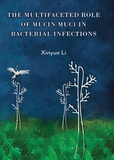The multifaceted role of mucin MUC1 in bacterial infections
Summary
MUC1 is a transmembrane mucin that is expressed at the apical surface of normal epithelial cells. It contains an ectodomain that is heavily glycosylated, a transmembrane domain, and a cytoplasmic tail (CT) with signaling capacity. MUC1 plays an important barrier role in defense against pathogens at the host-microbe interface. In contrary, MUC1 can also be exploited as an adhesion receptor by some pathogens to promote their colonization and invasion of epithelial cells. So far, many mechanistic aspects remain unexplored. We aimed at exploring the role of MUC1 domains in bacterial pathogenesis at the cellular level. The intestinal pathogen Salmonella enterica is one of the most common causes of human foodborne infections. We discovered that MUC1 could promote Salmonella efficient apical invasion of intestinal epithelial cells. The MUC1-ectodomain, instead of the MUC1-CT is crucial in this process. Salmonella utilizes its giant protein (SiiE) to engage sialic acids on the MUC1-ectodomain to promote its invasion. In another aspect, MUC1 induces cellular morphology changes and primes integrin clustering to activate signaling. Various pathogens utilize integrins to enter host cells. We found that MUC1 could modulate β1-integrin-mediated bacterial invasion. This requires a concerted action of the MUC1-ectodomain and the MUC1-CT. Lastly, nuclear trafficking of the MUC1-CT has been reported, but the factors that facilitate this event are largely unknown. We developed a novel system with nuclear targeting signals to screen for microbial factors that trigger MUC1-CT nuclear trafficking and for disclosing the unexplored functions of the nuclear-localized MUC1 fragments in epithelial cells.
